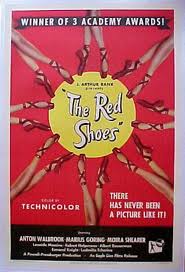
THE RED SHOES
UK, 1948, 136 Minutes, Colour.
Anton Walbrook, Marius Goring, Moira Shearer, Leonide Massine, Robert Helpmann.
Directed by Michael Powell and Emeric Pressburger.
The Red Shoes is considered a classic ballet film and was very popular in the late 40s. It made ballet very respectable on the cinema screen for wide audiences. Directors Emeric Pressburger and Michael Powell tried to repeat their success some years later with the presentation of The Tales of Hoffmann. Powell and Pressburger had worked together in many films, eg. A Matter of Life and Death. They were to make a number of war tributes in the 50s. Moira Shearer was a successful ballet dancer at the time and can be seen in The Tales of Hoffmann, The Story of Three Loves and other ballet films. Anton Walbrook had a fascinating power in the English cinema at the time for rather exotic, continental, fascinating men. Robert Helpmann, Leonide Massine and other successful ballet dancers of the time form the supporting cast. The film is interesting in presenting a ballet company at work, the Svengali-Trilby? story in a ballet context. The ballet music was written especially for the film by Brian Easdale.
1. The film is considered a ballet cinema classic. Why? Its skills, qualities, entertainment value? Parable value? The appeal of ballet, of dance, of music? The cinema making them more available for a wide audience?
2. The presentation of ballet in cinema form? The differences from theatrical performance? Skill, beauty, drama? How well did the ballet sequences blend with the drama of the film?
3. How well did the screenplay and the direction combine ballet, the drama of the overall film and the parallels with the heroine of the film and of the, ballet itself? The fable, tragedy?
4. A British film of the late 40s? The British atmosphere, Europe? The colour styles, the musical score, the choreography?
5. The basic plot of the film: the basic theatre story, the creator, his ambitions, his hold over the young star who is emerging, her ambitions and hopes, guidance, passion, the clash of the love story, tragedy? The material is fairly conventional. How well was it presented her? Did the film transcend the conventions and even the cliche?
6. Moira Shearer's beauty and skill as Vickie? The screenplay's focus on her and audience identification with her? An ordinary young girl, her character, hopes and ambitions, her background, her willingness to be guided, the hard work? The growing love for Julian Craster? The contrast of her relationship with him as with Lermontev? His hold over her, tyranny, mesmerising power? How did he eventually control her life? Could she have broken the spell?
7. Her growth in success, its effect on her? How were the theatre scenes balanced with the scenes with Julian? The build-up to jealousy in Lermontev?
8. Julian Craster as the talented young man, his hopes, work with Lermontev? The contrast of the two men? Julian's love for Vickie but his inability to hold her? Could he have saved her from tragedy?
9. Lermontev as the creative genius, his hypnotic power, jealousy, control? What did he live for? His cruelty in being the power behind the tragedy?
10. The supporting cast and their presentation of the ballet company, life within the company, frictions, joys, rehearsals etc.?
11. The contrast with the English atmosphere and the Riviera? The importance of the Riviera background for the climax of the film?
12. The beauty of the ballet, the way that Vickie danced it, its parallels with her life? The insight into character via the ballet? AS a fable lived out in real life?
13. The impact of Vickie’s death? What possessed her? The significance and reference of the title? Her passion and achievement?